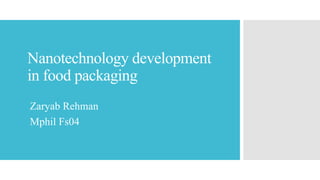
Nanotechnology development in food packaging.pptx
- 1. Nanotechnology development in food packaging Zaryab Rehman Mphil Fs04
- 2. Out lines Food Packaging Nano Technology Shortcomings of existing packaging systems Nanocomposite developments Nano technology development- Active Packaging Nanotechnology developments in intelligent packaging Perspectives and concerns Conclusion
- 3. Food Packaging Packaging provides containment and protects food products during distribution and storage from external and internal unfavorable conditions. Packaging has become the third largest industry in the world. Besides these functions, it provides essential product information to consumer to facilitate the promotion and advertisement of the product.
- 4. Active packaging Packaging in which constituents are deliberately added into the packaging system to enhance the performance of packaging material. It is the type of packaging material that can monitor the internal and external conditions of packaging material. Intelligent packaging
- 6. Nano Technology Nanotechnology involves the exploitation of materials with one or more dimensions that are less than 100 nm. The nanomaterials can dramatically enhance the material properties of the resulting nanocomposites such as improved mechanical strength, enhanced thermal stability, increased electrical conductivity, and so on.
- 7. Shortcomings of existing packaging systems Non-sustainable production, lack of recyclability, insufficient mechanical and barrier properties are some of the ongoing challenges faced by the food and packaging industries. Food producers want to achieve an adequate shelf-life for their products while maintaining the optimal quality and safety of the products. Research and development activities in the academia and industry have been focused on exploiting nanotechnology to solve the challenges Opportunities for nanotechnology
- 8. Nanocomposite developments Nanocomposite technology has been shown to be useful for enhancing material properties of biopolymer. Nanocomposites comprised of a single or a mixture of polymers with at least one organic or inorganic filler that has a dimension lower than 100 nm. Incorporation of nanoparticles such as SiO2, clay, KMnO4 , nanocellulose, nano fibrillated cellulose, carbon nanotubes and so on into biopolymers and synthetic polymers can enhance their mechanical and barrier properties. Enhanced mechanical and barrier properties of food packaging
- 10. Nano technology development In active packaging systems, the protection function of a package is enhanced by incorporating into it active compounds such as antimicrobial compounds, preservatives, oxygen absorbers, water vapor absorbers, ethylene removers, and so on. Active packaging
- 12. The active components are assembled using nanotechnology to produce an active component carrier that can be integrated into a food package. The carrier can interact with internal and/or external factors (blue arrows), thereby activating an intended action (red arrow) that enhances the shelf-life, food quality, and/or safety of the product.
- 13. Nanotechnology developments in intelligent packaging The hallmark of intelligent packaging systems is to enhance the communication aspect of a package, such as to dynamically reflect the actual quality of the food in real time. This type of advanced packaging is useful to increase the efficacy of information transfer during product distribution chain via innovative communication methods such as intelligent tags (e.g., radiofrequency identity tags, time-temperature indicators, oxygen and carbon dioxide sensors, freshness indicators.
- 15. Perspectives and concerns Nanotechnology will play a major role in filling the gaps of packaging material developments in active and intelligent packaging areas. The main risk associated with nano-sized components is their migration into to the food. Some nanoparticles can induce intracellular damages, pulmonary inflammation and vascular disease. The other is cost effectiveness and consumer acceptance.
- 16. Conclusion In conclusion, nanotechnology will serve as an important tool to overcome existing challenges that are associated with packaging materials. This advancement will positively affect the shelf-life, quality, safety, and security of foods, which will ultimately benefit both the producers and consumer.